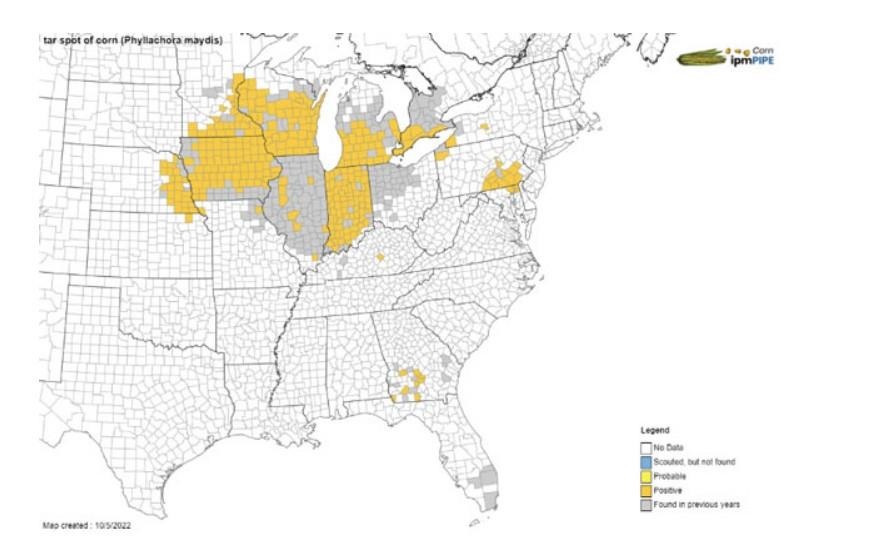By Rodrigo Onofre
Tar spot of corn, a disease caused by the fungus Phyllachora maydis, has been confirmed in Nemaha (9/15) and Doniphan (10/05) counties in Kansas. Through a collaborative effort with K-State County Extension Crop Agents, five fields in Nemaha county and one field in Doniphan county have been confirmed positive for tar spot. Tar spot lesions are black, raised, and have a round/elliptical shape. This pathogen can survive in crop residue (Figure 1).

Figure 1. Tar spot of corn. Purple arrows are indicating a few of the tar spot lesions. Photo courtesy of Rodrigo Onofre, K-State Research and Extension.
Tar Spot was detected in US for the first time in 2015 and has quickly spread through the Midwest (Figure 2). To date, it has been reported in Illinois, Indiana, Wisconsin, Michigan, Minnesota, Kentucky, Iowa, Ohio, Florida, Georgia, Pennsylvania, New York, Nebraska, and Missouri. First observations in our neighboring states, Nebraska and Missouri, were made last season. This disease is favored by mild temperature (60F to 73F), high relative humidity (>75%), and a prolonged leaf wetness period (>7h). Severity of tar spot is dependent on the weather. Irrigated corn may be at particularly high risk for yield or silage loss.
Producers should consider harvesting fields confirmed to have tar spot last to mitigate additional disease spread. Because of this, scouting prior to harvest is critical.
Current management recommendations for this disease:
- Avoid highly susceptible hybrids
- Introduce crop rotation (this pathogen survives in corn residue)
- Manage irrigation
- Use fungicides that have active ingredients with more than one mode of action.
Efficacy ratings for fungicides labeled for the control of tar spot can be found at the Crop Protection Network website, link:
https://cropprotectionnetwork.s3.amazonaws.com/CPN2011_FungicideEfficacyControlCornDiseases_04_2022-1650470887.pdf

Figure 2. Tar Spot of Corn (Phyllachora maydis) in Kansas and surrounding states for 2022. Source: https://corn.ipmpipe.org/tarspot/
Source : ksu.edu